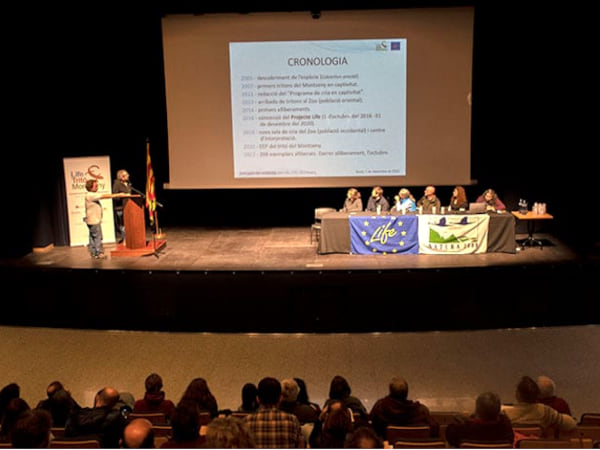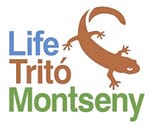Slider 3
Life Tritó Montseny
Un símbol de la natura del Montseny
Subbanner
LIFE15 NAT/ES/000757
Project of conservation of an only species to the world
Breadcrumb
Evolution
Evolution of the project Life Tritó Montseny
Asset Publisher


Closure of LIFE
09/12/2022 11:54 h.
Experts, researchers and managers took stock of six years of work
On Thursday, December 1, the closing day of the European project Life Tritó Montseny took place in the Multipurpose Hall of Seva. It served to review all the advances in the work to conserve this endemic amphibian of Montseny that is critically endangered and to lay the foundations for further work on its conservation beyond the European project.
During the conference, the management and conservation work for the improvement of the newt's habitat in the upper Tordera basin was presented, where the aim is to guarantee both the ecological flow and the hydrological quality of the streams it inhabits. The threats to this habitat, linked to the conservation of riparian forests, were also discussed. Thus, it was concluded that some traditional works, such as the extraction of wood and water, must be changed so that they do not affect its habitat.
Likewise, the conference devoted special attention to captive breeding at the Barcelona Zoo, at the Wildlife Center of Pont de Suert, at Chester Zoo and from 2021 at the Center for Research and Environmental Education of Calafell (CREAC). The aim of the breeding is to maintain a genetic reserve of 300 individuals. In these years, more than 5,700 larvae have been reared and 2,600 individuals have been released.
In the presentation of the conference, the representatives of the administrations showed their willingness to continue working and provide resources for the continuity of the actions initiated by the European project, with the aim of adding new partners who wish to become involved. In this way it will be possible to increase the capacity for action and reaction in the preservation of the habitats of the Montseny.
The project coordinator, Daniel Guinart, conservation technician of the Montseny Natural Park, pointed out that after six years we know much more about the Montseny newt and its conservation status, but it is still in a critical state and in the future, with climate change, this animal will have a very difficult time. The current situation of its population is stable but drought, rainfall deficit and high temperatures do not benefit its conservation.
The head of conservation and knowledge of the Barcelona Zoo, Juli Mauri, also remarked the importance of the newt in the new zoo model, since in one species it brings together elements such as species conservation, research and education.
Six years of actions for the conservation of the Montseny newt and its habitat
The European Life Tritó Montseny project began in September 2016 and was due to end in December 2020, once the objectives set for a total of forty-nine planned actions had been achieved, with which to solve the main threats to the species and ensure conservation. Once this date was reached, a two-year extension period was granted for twenty-five actions that had not been possible to achieve.
During these years, a large number of actions linked to research and dissemination have been developed, as well as interventions in the territory to, for example, try to guarantee river connectivity, restore riverbank habitats or ensure the flow of torrents.
Amphibians are one of the most endangered species and their presence is a basic environmental indicator to know the quality of the water and the natural environment of these territories. Thus, the work carried out all these years has shown that, mainly due to the effect of the hydrology of the area and climate change, the situation of this amphibian remains in critical danger of extinction, although its population is stable.
End of the project
The closing day brings to an end the six years of the European Life Tritó Montseny project. In total, the 49 actions planned for the Montseny newt and its habitat have been achieved. Since its inception, the technicians involved in the project have been regularly monitored by the European Commission and have submitted annual audit reports. At the administrative level, the project ends in March 2023 with the delivery of the final report to the European Union.
Although the project is coming to an end, the newt breeding centers will remain active and staffed with newt breeders. During the first months of 2023, the methodology to be followed to continue preserving this Montseny endemism and its riverside habitat will be defined.
Regarding the communication of the project, the web page will continue to be active and all its contents will be available for consultation. Since the beginning of the website, 143 news items and 15 quarterly newsletters have been disseminated in electronic format, in three languages: Catalan, Spanish and English. Although from 2023 onwards no more news will be generated, you can still consult the news that have appeared in the media, press releases and all the communication resources disseminated on the website since the beginning. The twitter channel will stop broadcasting tweets, but the Youtube channel is still active and you can continue to watch the videos and capsules of the project.


